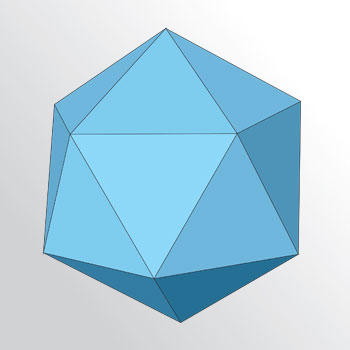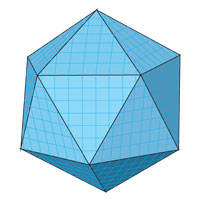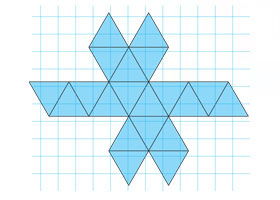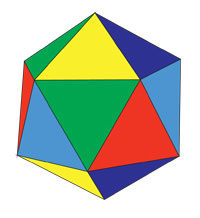

Develop spatial imagination
0.00 $
0 item(s)
Icosahedron. How to make pdf template
The ancient Greeks gave the polyhedron a name according to the number of faces. “Ikosi” means twenty, “hedra” means a face (Icosahedron is solid with twenty faces).
Therefore, the question “What is an icosahedron?” The following definition can be given: “An icosahedron is a geometric solid of twenty faces, each of which is a right triangle.”
The polyhedron belongs to regular polyhedra and is one of the five Platonic solids.
The icosahedron has the following characteristics:
The face type is a regular triangle;
The number of sides at the verge 3;
The total number of faces is 20;
The number of edges adjacent to the top is 5;
The total number of vertices is 12;
The total number of edges is 30.
The regular icosahedron is composed of twenty equilateral triangles. Each vertex of an icosahedron is a vertex of five triangles. Therefore, each vertex's sum of flat angles is 300° (60° * 5).
The icosahedron has a center of symmetry - the center of the icosahedron has 15 axes of symmetry and 15 planes.
Popular
One of the most famous magazines in Russia - popularizers of science with 115 years of history-...
A polyhedronis a solid bounded by flat polygons, which are called faces....
The popular television series "Game of Thrones" is interesting not only by the complex plot, the...
Quite often, a question about the practical use of paper models pops up. What is the point of...
With the same pattern repeating on each polyhedrons face, it is possible to create an alternating...
The Lighthouse of Alexandria, one of the Seven Wonders, was built in the 3d century BC in an...

 An icosahedron can be placed in a sphere (inscribed) so that each of its vertices will touch the inner wall of the sphere.
An icosahedron can be placed in a sphere (inscribed) so that each of its vertices will touch the inner wall of the sphere. Where "a" - is the side length.
Where "a" - is the side length.




 The following formula determines the volume of the icosahedron:
The following formula determines the volume of the icosahedron:








